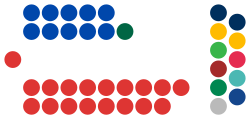Victorian parliament
| Parliament of Victoria | |
|---|---|
| 58th Parliament | |
 |
|
| Type | |
| Type | |
| Houses |
Legislative Assembly Legislative Council |
| History | |
| Founded | 21 November 1856 |
| Leadership | |
|
Elizabeth II
Since 6 February 1952 |
|
|
Linda Dessau
Since 1 July 2015 |
|
| Structure | |
| Seats |
128 88 MLAs 40 MLCs |
 |
|
|
Legislative Assembly political groups
|
Government (46) Labor (46) Opposition (38) Liberal (30) National (8) Crossbench (4) Greens (2) Independent (2) |
 |
|
|
Legislative Council political groups
|
Government Labor (14) Opposition (16) Liberal (14) National (2) Crossbench (10) Greens (5) Shooters (2) DLP (1) Sex Party (1) Local Jobs (1) |
| Elections | |
|
Last general election
|
29 November 2014 |
|
Next general election
|
24 November 2018 |
| Meeting place | |
 |
|
|
Parliament House, Melbourne, Victoria, Australia |
|
| Website | |
| www.parliament.vic.gov.au | |
The Parliament of Victoria is the bicameral legislature of the Australian state of Victoria. It follows a Westminster-derived parliamentary system and consists of The Queen, represented by the Governor of Victoria; the Legislative Assembly (lower house); and the Legislative Council (upper house). The Parliament meets at Parliament House in the state capital Melbourne.
The two Houses of Parliament have 128 Members in total, 88 in the lower house and 40 in the upper house. Victoria has compulsory voting and uses preferential ballot in single-member seats for the lower house, and single transferable vote in multi-member seats for the proportionally represented upper house. Government is formed in the lower house while the upper is a house of review. All members serve four-year terms.
The incumbent Labor Party government, elected at the 2014 election, holds a 3-seat majority in the lower house as of the 1 December 2014.
Prior to 1851 the area of Australia now known as Victoria was part of the colony of New South Wales and was administered by the Government of New South Wales in Sydney. On 5 August 1850, the Parliament of the United Kingdom passed the Australian Colonies Government Act which made provision for the separation of Victoria from New South Wales. Enabling legislation was passed by the Parliament of New South Wales, and Victoria was formally created a separate colony of the United Kingdom on 1 July 1851.
...
Wikipedia
